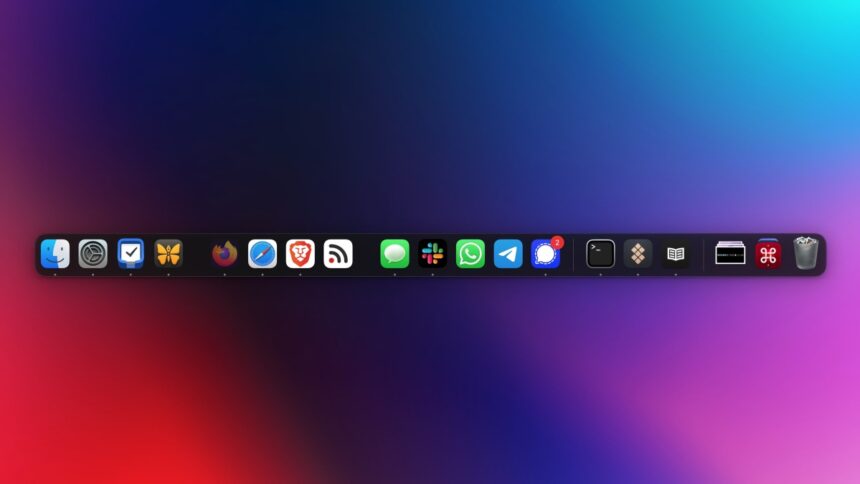Customizing Your Mac Dock: A Comprehensive Guide
The dock is a signature feature on Mac computers, serving as a tool for launching applications, switching between tasks, and providing a space for essential apps and minimized windows. With a default minimalistic design featuring a select few applications that your system predicts you will frequently utilize, there’s room for significant personal customization. By tweaking it, you can remove irrelevant icons, alter its appearance, and even change its position. Here’s everything to consider when customizing your dock, along with some valuable extras.
Eliminate Unused Apps
Begin by letting go of applications you don’t plan to use. To remove an application from your dock, right-click its icon and choose Options > Remove from Dock. Additionally, to ensure that temporarily used apps (which can be found on the right side of the dock, separated by a line) remain there, right-click their icons and select Options > Keep in Dock.
Rearranging Apps for Quick Access
Next, organize the applications within your dock to enhance accessibility. This is a simple task: just click and drag the icons to your desired location. However, be cautious; dropping an icon outside of the dock will remove it, and you will have to add it back manually.
Adjust the Dock’s Size
Another customization option is resizing the dock. Move your cursor over any of the separators (the vertical lines within the dock). Your cursor will then change to an up-and-down arrow. Dragging it up will enlarge the dock, while dragging it down will reduce its size.
Alternatively, you can resize the dock by clicking the Apple icon in the upper-left corner and navigating to System Settings > Desktop & Dock. Use the Size slider to make adjustments.
Adjust the Dock’s Location
You can reposition your dock to either side of the screen to maximize workspace. To do this, right-click on an empty area of the dock and choose Position on Screen. Select either Left or Right for a vertical alignment, or Center to revert to the default placement.
This option is also available in System Settings > Desktop & Dock > Position on screen.
Automatic Hiding of the Dock
If simplicity is preferred, consider enabling the auto-hide feature for the dock. It won’t disappear entirely; it will only show itself when the cursor approaches its area. This is particularly useful on smaller screens. To enable this feature, go to System Settings > Desktop & Dock > Automatically hide & show the dock. Alternatively, you can use the shortcut Command-Option-D to toggle this feature.
Disable Recently Opened Apps Feature
The right side of your dock displays your most recently accessed applications. If this feature is distracting, disable it by navigating to System Settings > Desktop & Dock and unchecking Show suggested and recent apps in Dock. While this feature can be handy for quick access to frequently used apps, it might not be ideal for those with limited screen real estate.
Minimize Windows into App Icons
When minimizing applications, each window normally appears as a separate icon in the dock, cluttering it quickly. Instead, macOS allows you to minimize windows directly into their respective app icons. To enable this, visit System Settings > Desktop & Dock and select Minimize windows into application icon. To retrieve a window minimized in an app icon, simply right-click it.
Conceal Open App Indicators
By default, a small dot indicates which apps are open. If preferred, these can be hidden. Navigate to System Settings > Desktop & Dock and disable Show indicators for open applications.
Modify Icon Magnification Settings
When hovering over app icons, they will automatically enlarge. You can change the intensity of this effect or turn it off in System Settings > Desktop & Dock.
Use the slider under Magnification to adjust this option, moving it left to disable or to the right for a larger effect. As a tip, if this feature is off, hold down Shift + Control to temporarily activate magnification when desired.
Adding Folders to the Dock
Folders can be added to the dock for quicker access, provided they’re in the Favorites bar of Finder. Open Finder, locate the folder to add, and drag it to the Favorites bar on the left. Then, right-click the folder and select Add to Dock.
This functionality can also be used to consolidate several applications into a single dock icon, perfect for keeping frequently used apps organized without cluttering the dock. Simply create a new folder in the Applications section of Finder, name it, move it to the Favorites bar, and add it to the dock.
Introducing Spacers for Better Organization
Enhance the organization of your dock by adding spacers or empty spaces. These can be purely aesthetic or functional for grouping similar apps. For this feature, Terminal is required. Open Terminal by pressing Command-Space, searching for it, and running the following command to create a full-sized spacer:
defaults write com.apple.dock persistent-apps -array-add '{tile-data={}; tile-type="spacer-tile";}' && killall Dock
For a smaller spacer, use this command instead:
defaults write com.apple.dock persistent-apps -array-add '{"tile-type"="small-spacer-tile";}' && killall Dock
To add multiple spacers, simply execute your chosen command multiple times. This will be the only use for Terminal, as spacers can be rearranged by dragging them or removed by dropping them outside the dock.
Personalize Application Icons
Further customize your dock by changing the appearance of app icons. This can enhance the overall aesthetic or align them with a specific theme. Check individual applications for icon changing options; if unavailable, explore the guide for modifying macOS app icons, which includes built-in methods and third-party tools. A great source for alternative icons is macOSicons.com.
Utilizing Third-Party Applications for Advanced Customization
For those looking to explore all possible dock configurations, third-party apps can unveil hidden customization features. Terminal commands may allow for accessing some options, but other functionalities might require specialized software. Consider using applications such as TinkerTool (free) or Supercharge ($11). These tools provide additional settings for optimizing your dock, such as eliminating delays when revealing the hidden dock or adjusting the dimness of concealed apps.
TinkerTool enhances spacer addition and prevents icon movement in the dock, whereas Supercharge allows dock folders to open directly in Finder instead of displaying their contents in the dock itself.
Dedicated Dock Customization Applications
If the primary goal is dock enhancement alone, exploring dedicated dock customization apps may yield the best results. These apps are specifically designed for cosmetic and functional modifications of the dock. Options such as DockFlow ($5.60) and uBar ($30) are excellent examples. DockFlow allows you to establish presets mimicking different work scenarios, such as gaming or social media, quickly switching between them as needed. Meanwhile, uBar reimagines the dock to resemble the Windows taskbar, which can be beneficial for those transitioning operating systems.












